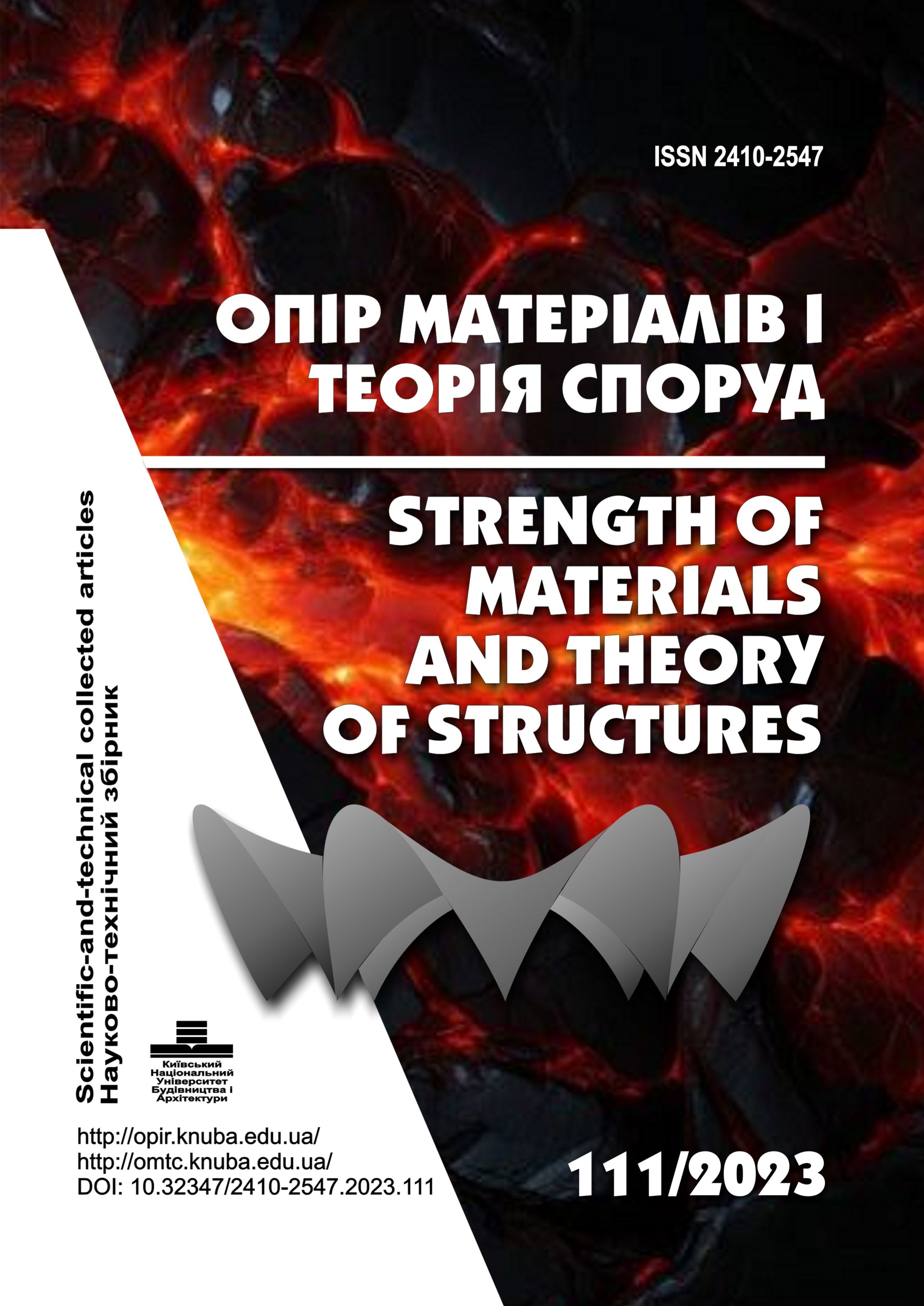Determination of internal efforts in the base finite elements of SAFEM
DOI:
https://doi.org/10.32347/2410-2547.2023.111.198-204Keywords:
bodies of revolution, internal efforts, semi-analytical finite elements method, longitudinal forces, shear forces, bending moments, torque momentsAbstract
The principles of calculating the internal efforts of a circular finite element in the semi-analytical finite element method (FEM) based on the obtained components of the stress tensor and the peculiarities of the approach associated with the use of the moment scheme of the finite element (FEM) are considered. Formulas for determining longitudinal, shear forces, bending and torque moments have been obtained.
A special place, among the variety of objects considered with the help of analytical and numerical methods, is occupied by bodies of revolution of complex shape and cross-sectional structure, formed by the movement of some creative surface along a closed or opened line without breaks. The selected geometric class is used as natural structures of nodes and details in construction of mechanical engineering. The sufficiently wide distribution of the specified forms in the construction and machine-building industries, on the one hand, and the possibility of significantly simplifying the solving relationships by taking into account their geometric features, on the other hand, provide a basis for the development and use of various modifications of the finite element method (FEM). The semi-analytical finite element method (SAFEM) is one such approach that has gained widespread use for solving problems whose objects are prismatic bodies and bodies of revolution of complex shape and cross-sectional structure. Due to the introduction of additional hypotheses that do not reduce the accuracy of the approximation, the representation of deformations and stresses in physical terms and in accordance with the moment scheme of the finite element (MSFE), on the one hand, it is possible to avoid the time-consuming procedure of numerical integration over the cross-sectional area of the finite element (FE), on the other hand - maintain the high efficiency of 3D discretization.
Despite the large number of publications devoted to the semi-analytical method of finite elements, the question of determining internal forces, which are often component factors of the strength criteria laid down in state building codes, is inappropriately neglected. The use of SAFEM in combination with МSFЕ creates some mathematical features of calculating internal longitudinal, shearing forces and moments.
References
Bazhenov V.A., Vabishchevych M.O., Pyskunov S.О., Solodei I.I. Chyselni doslidzhennia neliniinoho deformuvannia prostorovykh til z urakhuvanniam rozvytku trishchyn pry statychnykh ta dynamichnykh navantazhenniakh (Numerical researches of nonlinear deformation of spatial bodies taking into account the development of cracks under static and dynamic loads). – Kyiv: Caravela, 2019. – 240 p.
Bazhenov V.A., GuljarO.I., Pyskunov S.О., Sakharov O.S.Napivanalitychnyi metod skinchenykh elementiv v zadachakh ruinuvannia prostovykh til (Semi-analytical finite element method in problems of 3D bodies destruction). - KNUCA, 2005. - 298 p.
Bazhenov V.A., GuljarA.I., Sakharov A.S., ToporA.G.Poluanaliticheskij metod konechnyh elementov v mehanike deformiruemyh tel (Semi-analytical finite element method in mechanics of deformable bodies). - Kyiv: Vypol, 1993, 376 p.
Bazhenov V.A., GuljarO.I., Sakharov O.S., Solodei I.I.Napivanalitychnyi metod skinchennykh elementiv v zadachakh dynamiky prostorovykh til (Semi-analytical finite element method in 3D dynamics problems). – Kyiv: Caravela, 2012. – 248 p.
Bazhenov V.A., GuljarA.I., Kozak А.L., RutkovskiiV.A., Sakharov A.S.Chislennoe modelirovanie razrusheniya zhelezobetonnyh konstrukcij po metodu konechnyh elementov (Numerical modeling of the reinforced concrete structures destruction using the finite element method). – Kyiv: Naukovadumka, 1996. – 360 p.
Bazhenov V.A., Pyskunov S.О., Solodei I.I.Chyselne doslidzhennia protsesiv neliniinoho statychnoho i dynamichnoho deformuvannia prostorovykh til (Numerical researches of nonlinear static and dynamic deformation processes of 3D bodies).– Kyiv: Caravela, 2017. – 308 p.
Sakharov A.S., Kyslookii V.N., KyrychevskiiV.V.Metod konechnyh elementov v mehanike tverdyh tel (Finite element method in solid mechanics). - Kyiv: Vyschaschkola, 1982.- 479 p.
Sakharov A.S.Momentnaya shema konechnyh elementov MSKE s uchetom zhestkih smeshenij (The moment finite element scheme(MFES) taking into accountof rigid offsets). // Strenght of materials and theory of structures. – 1974. – Issue 24. – P. 147–156.
Bazhenov V.A., Pyskunov S.О., Solodei I.I. Сontinium mechanics: semi-analytical finite element method. -Cambridge Scientific Publisher, 2018, 236 p. ISBN 978-1-908106-63-6.
Solodei I.I., Petrenko E.Yu, Zatyliuk Gh.A. The stress-strain state investigation of underground structures on the basis of soil models with adjusted input parameters // Strenght of materials and theory of structures. – 2019. – Issue 103. – P. 63–70.
Solodey I.I., Zatylyuk H.A. Study of the reliability and efficiency of using reinforced soil models within the framework of the finite element method // Strenght of materials and theory of structures. – 2022. – Issue 109. – P. 30–37.
Downloads
Published
Issue
Section
License

This work is licensed under a Creative Commons Attribution 4.0 International License.
Authors retain copyright and grant the journal right of first publication with the work simultaneously licensed under a Creative Commons Attribution License that allows others to share the work with an acknowledgement of the work's authorship and initial publication in this journal.

